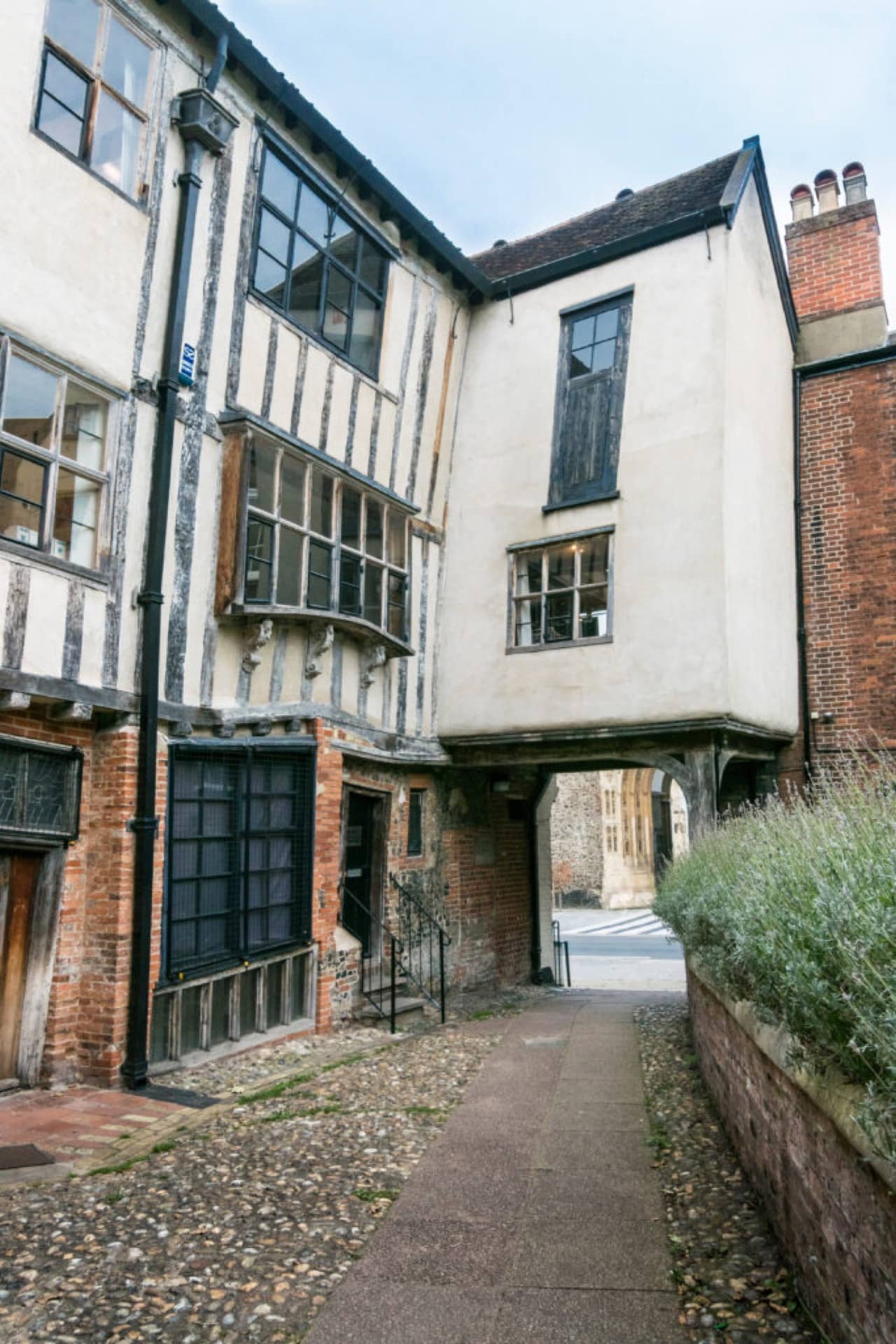
The Wildboy of Bridewell Alley
The Wildman in Norwich mixes some of the best cocktails in town. But do you know how the forest-inspired pub got its name?
In 1751 Bridewell Gaol (now the Museum of Norwich) was engulfed by the smoke of a street fire. Among the hastily released prisoners, one man stood out. Hirsute, strong, and unable to use words, he’d been arrested for ‘strolling about the streets’. Yet astonishingly, this poor vagrant had once lived in Kensington Palace under the King’s protection. Peter The Wild Boy had been found. In Norwich.
His story began in Hamelin, Germany in 1725. A naked boy of about 12 was discovered alone in the forest; a feral child, scampering on all fours, surviving on plants. Fascinated, King George I brought him to the English court and called him Peter. The wild boy was a sensation. He caught the imagination of writers like Daniel Defoe and Jonathan Swift and there was fevered speculation he’d been raised by wolves or bears. Eventually, the court paid for a Hertfordshire farmer to care for Peter, who seemed happiest in the countryside. But in summer 1751, aged 39, Peter vanished. Despite press advertisements, he couldn’t be traced. Until he turned up in Norwich.
He was taken home and looked after in Hertfordshire for the rest of his days. But Norwich people never forgot the famous Wild Boy who’d mysteriously turned up in their city. The Wildman Pub on Bedford Street is named in his honour, with a commemorative plaque nearby.
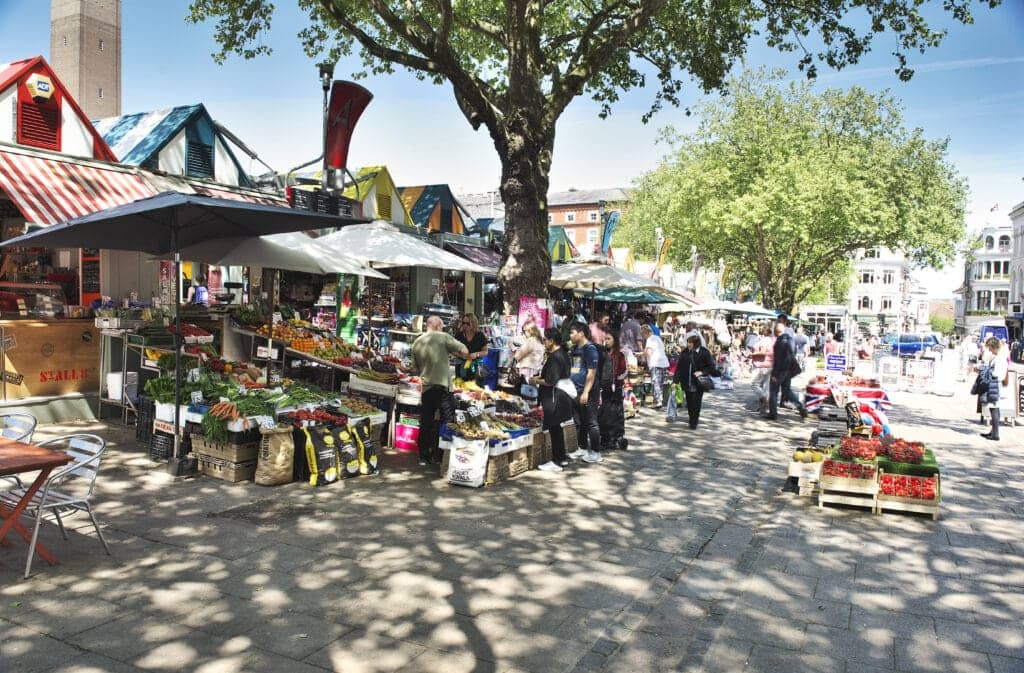
Norwich Market
For more than 1,000 years, there’s been a cosmopolitan street market right in Norwich city centre. Today there are almost 200 stalls, 30 street food vendors and over 90 independent businesses. This very English market with a buzzy international vibe is home to flavours from places like Chile and Japan, Shanghai and Punjab – with plenty from Norfolk too! Snazzy striped awnings make this a photogenic tourist landmark, yet it’s still very much a local’s market. Students chat over noodles, grandchildren are treated to creamy hot chocolate and city workers pick up the season’s finest flowers, fruit and veg, bread, cheese and meat. In autumn all shapes of mushrooms and squashes are piled high, in spring you’ll find the earliest rhubarb and wild garlic. There are fantastic preloved clothes, zingy green houseplants and home essentials. It’s an exciting destination for Christmas shopping and sourcing delectable things for a winter feast.
The Saxon market was in Tombland, moved to its current site by the Normans and generations have traded local goods, heckled street entertainers and shared gossip here in the city’s historic heart. Stalls are proud to sell produce from all over Norfolk, yet the UK’s largest open-air market is centre of a coastal county, always looking outward to the sea, with a long tradition of exotic imported goods such as tulips from Amsterdam, furs from Russia, walrus ivory from Scandinavia and wool from Flanders. Contemporary tastes change and Norwich Market’s diverse character keeps up, always flourishing with the times.
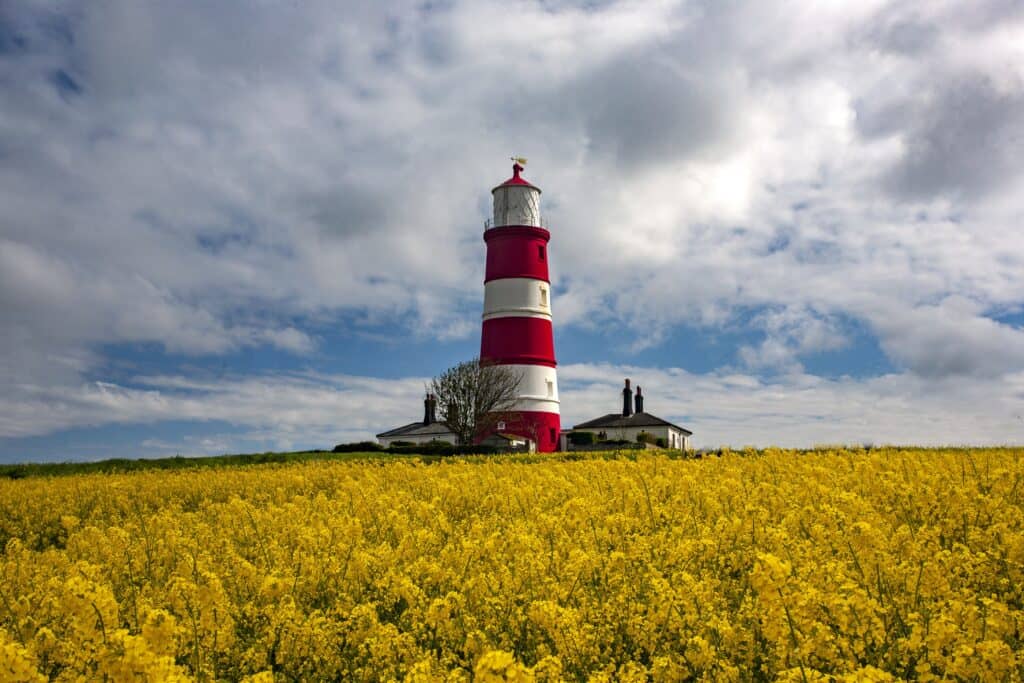
Happisburgh Lighthouse
On the east coast of Norfolk stands an enigmatic lighthouse. Facing the sunrise, it sits proudly on Happisburgh’s soft sandy cliffs where each morning the first rays of light catch the colourful facade, bathing its red and white stripes in the orange glow of a new day. This photogenic landmark was built in the wake of a terrible tragedy. In 1789 a terrible storm blew up. 70 sailing ships were wrecked in the crashing waters and 600 men lost their lives. The subsequent enquiry drew attention to the lack of warning lights between Cromer and Winterton so in 1791 two lighthouses were constructed. The ‘Low Light’ is now demolished but the ‘High Light’ is the distinctive tower that survives today. Once the ‘Low Light’ had gone, during daylight it was necessary to distinguish the Happisburgh lighthouse from the tower at Winterton and so three spectacular broad red bands were painted on the Happisburgh tower, just as you see today.
In 1987 Happisburgh Lighthouse was one of five lighthouses declared redundant with decommissioning scheduled for summer 1988. But local people were not going to allow their beloved lighthouse to be torn down! They mobilised and in 1990 a Private Bill was granted Royal making Happisburgh Britain’s only independently operated working lighthouse. It’s also the oldest working lighthouse in East Anglia, looked after by the Happisburgh Lighthouse Trust. It’s fascinating to look inside so if you can’t make one of the set open days, contact them to arrange a private visit.
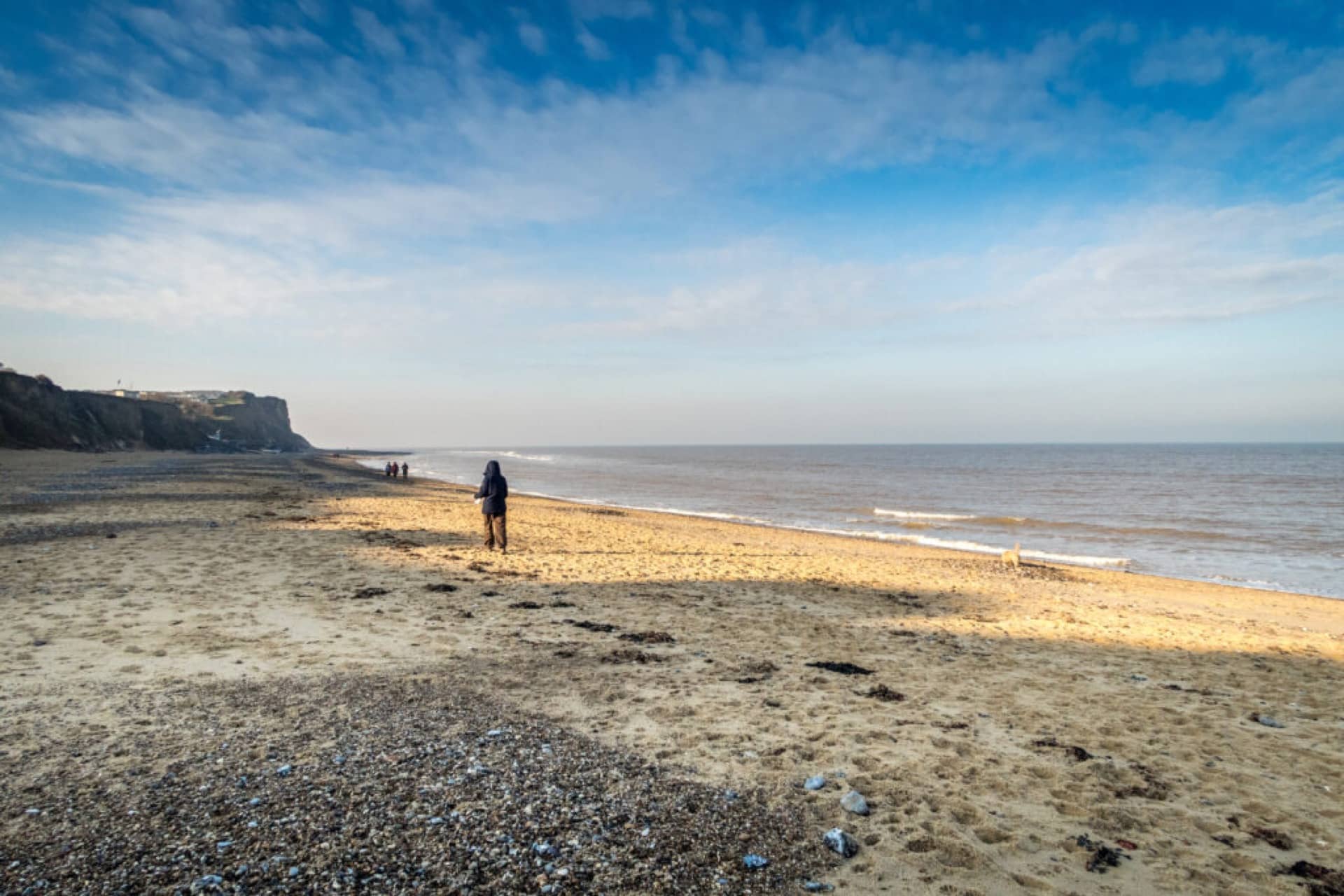
Black Shuck
It’s official, Britain is a nation of dog lovers. Unless that dog is Black Shuck! The spectral hound with a single fiery eye prowls across East Anglia, spotted everywhere from woods and lanes to coastal paths and bus stops. Midnight churchyards are a favourite haunt and Shuck seems particularly fixated on Cromer in North Norfolk – yikes!
Take a winter walk across this haunted land, as smugglers once did while nosey neighbours, terrified by their threatening tales, cowered at home by the fire. Luckily Cromer’s winding streets are full of pubs, cafés, delis and restaurants to get away from roaming phantoms, ready for a night of good food and cosy ghost stories.
Black Shuck is a spirit of the old world and the new, stalking from legend into popular imagination through films, graphic novels, video games, rock music and Sir Arthur Conan Doyle’s Sherlock Holmes story ‘The Hound of the Baskervilles’. In his 1901 ‘Highways & Byways in East Anglia’ W.A. Dutt wrote: “you will do well to shut your eyes if you hear him howling; shut them even if you are uncertain whether it is the dog fiend or the voice of the wind you hear.” A sighting is said to foreshadow misfortune, though others say Shuck guides lost travellers to safety over the marshes. Perhaps it depends if your pocket’s full of doggie treats! But just in case, if you’re passing a Norfolk churchyard at night, take local advice and don’t make eye contact with any giant hell hounds!

Deep History
On a winter walk at West Runton you’ll probably see a few happy dogs racing on the beach. Yet go back about 600,000 years and you’d be more likely to see elephants. Actually, Harold and Margaret Hems did see one, in December 1990. At least, they saw its pelvic bone, poking out of the cliff after a violent winter storm. Five years later a full excavation unearthed the oldest and largest Steppe Mammoth skeleton ever found in the UK. Standing at 4m tall and weighing 10 tonnes, this gigantic prehistoric mammal has become a local legend.
A towering creature, the Steppe Mammoth – Mammuthus trogontherii – roamed this ancient place with rhino, bison, beaver, hyena and also stone age settlers. But they shared a very different view to the one we see today. In fact our ancestors could have walked from Norfolk to Holland without getting their feet wet because the choppy North Sea was a land of rivers, grasses and savannah. Imagine that as you gaze at the horizon!
The mammoth’s near complete but fragile skeleton is preserved by Norfolk Museum Services. You can see part of it in Cromer Museum and find out more at West Runton Beach Café’s learning hub.
When winter gales scour the Norfolk coast and chunks of eroding cliff crumble down, a walker might scout a pre-historic fossil, perhaps a fragment of deer antler or mysterious mammal bone. But no one has been as fortunate as Mr and Mrs Hems. At least, not yet…
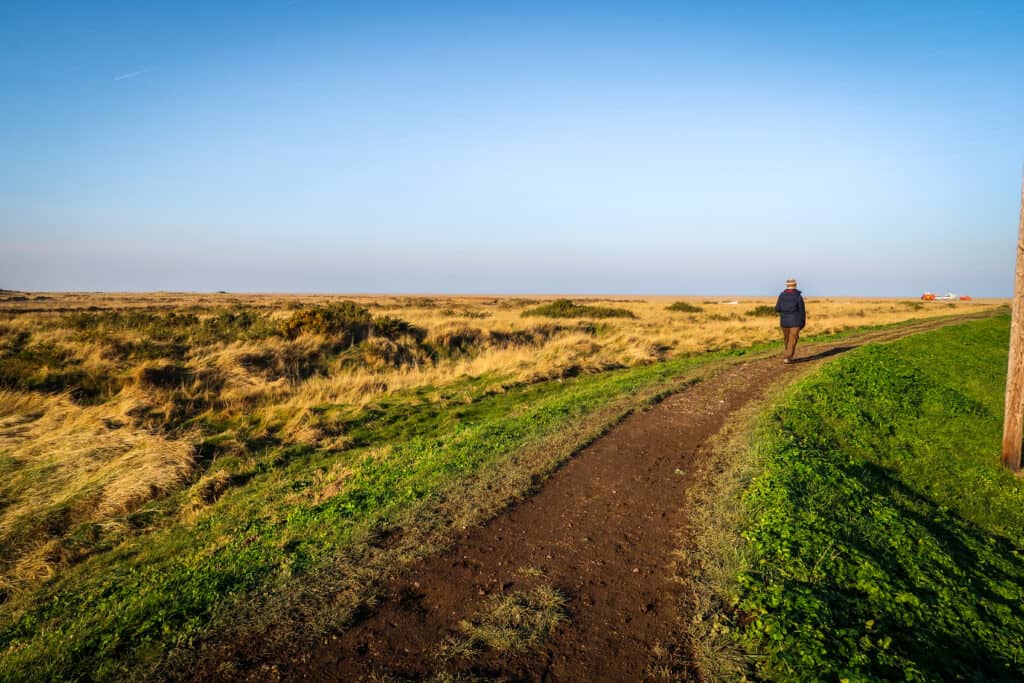
Salthouse Heath
There’s something about a winter afternoon in Salthouse that tugs the heart. Perhaps its the pale coastal light pouring through church windows, or smell of woodsmoke from cottages near the Heath. Maybe it’s the Heath itself, its wildness and sense of ancient lives whose stories are held by the earth, just beyond our sight.
Salthouse Heath was formed by melting glaciers thousands of years ago and is part of the geological Cromer Ridge. The rich mosaic of dry acid heath and grassland, fragrant gorse and broad-leaved woodland also guards a wealth of archaeological treasures. There are 11 scheduled monuments and a Bronze Age cemetery. And the remains of a World War II radar station to the north of the heath.
Heathland once defined much of Norfolk, yet is now a rare habitat. The 99-hectares of dry coastal heathland at Salthouse is one of the last remaining examples. Stand on this escarpment and drink in the stunning panorama of marsh, water, land and sea. It’s one of the most splendid views in Norfolk. From Cley Marsh Visitor Centre head towards the East Bank. Cross the coast road, follow the path through Walsey Hills, up past Great Hulver Hill and continue to Bridgefoot Lane. Turn left until you meet the path across onto Bard Hill, then head across the heath east towards Bloomstile Lane and just follow the road as it saunters down to Salthouse village where The Dun Cow pub will have the fire lit and a welcome waiting.
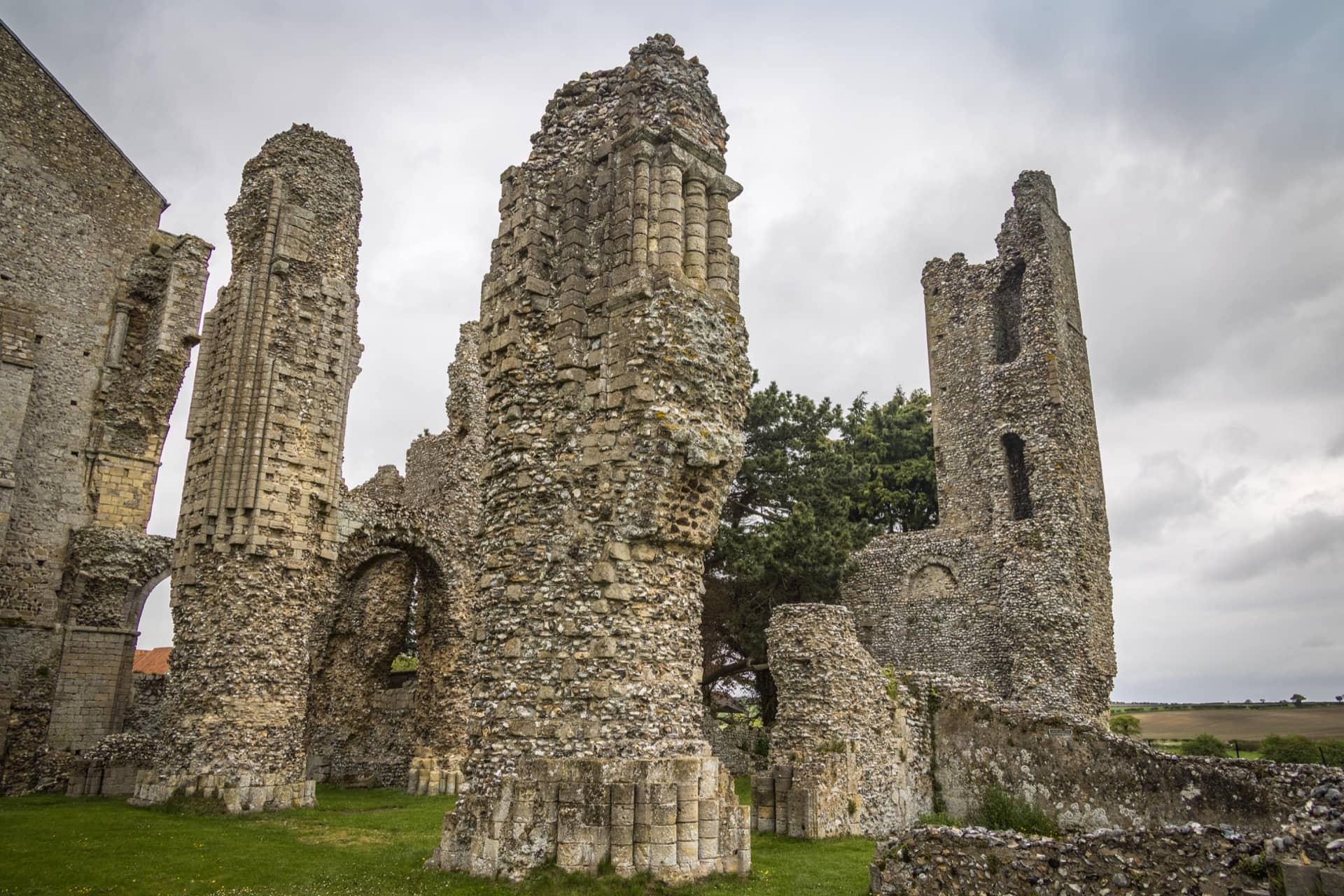
The Fiddling Ghost of Binham Priory
Listen. The wind has dropped. Evening’s soft shroud unfolds. All is held in wintry stillness. Midnight. Is that the sound of distant music? A mournful tune is coming from deep underground, an aching melody of loss and regret. For in this place only the dead are unquiet.
You’re at Binham Priory, one of Norfolk’s most magnificent ruins. Founded in 1091 by Peter des Valoines, William the Conqueror’s nephew, for 400 years it was home to a small community of Benedictine monks, led by a succession of scandalous priors. In the early 1300s, Prior William de Somerton’s obsession with alchemy plunged Binham into debt, church treasures sold off to fund occult experiments. In 1539 Henry VIII gave the monastery to Sir Thomas Paston, who pulled it apart to build a house. Demolition continued under Paston’s grandson, Edward, until falling masonry killed a workman, surely an ill omen. And so the rest fell into ruin, left to weather, time and ghosts.
A black-hooded monk has been seen emerging from a tunnel thought to join these ruins to the Walsingham shrine. And what of the haunting music? You’d hope having a dog named Trap would’ve made Jimmy Griggs think twice about striding down a crumbling old tunnel. But no! The foolhardy fellow marched in, showing off, playing his fiddle. Suddenly the music ceased. That night a great storm roared in from the sea and the tunnel caved in. Jimmy was never seen again. But you’ve heard his music, haven’t you?
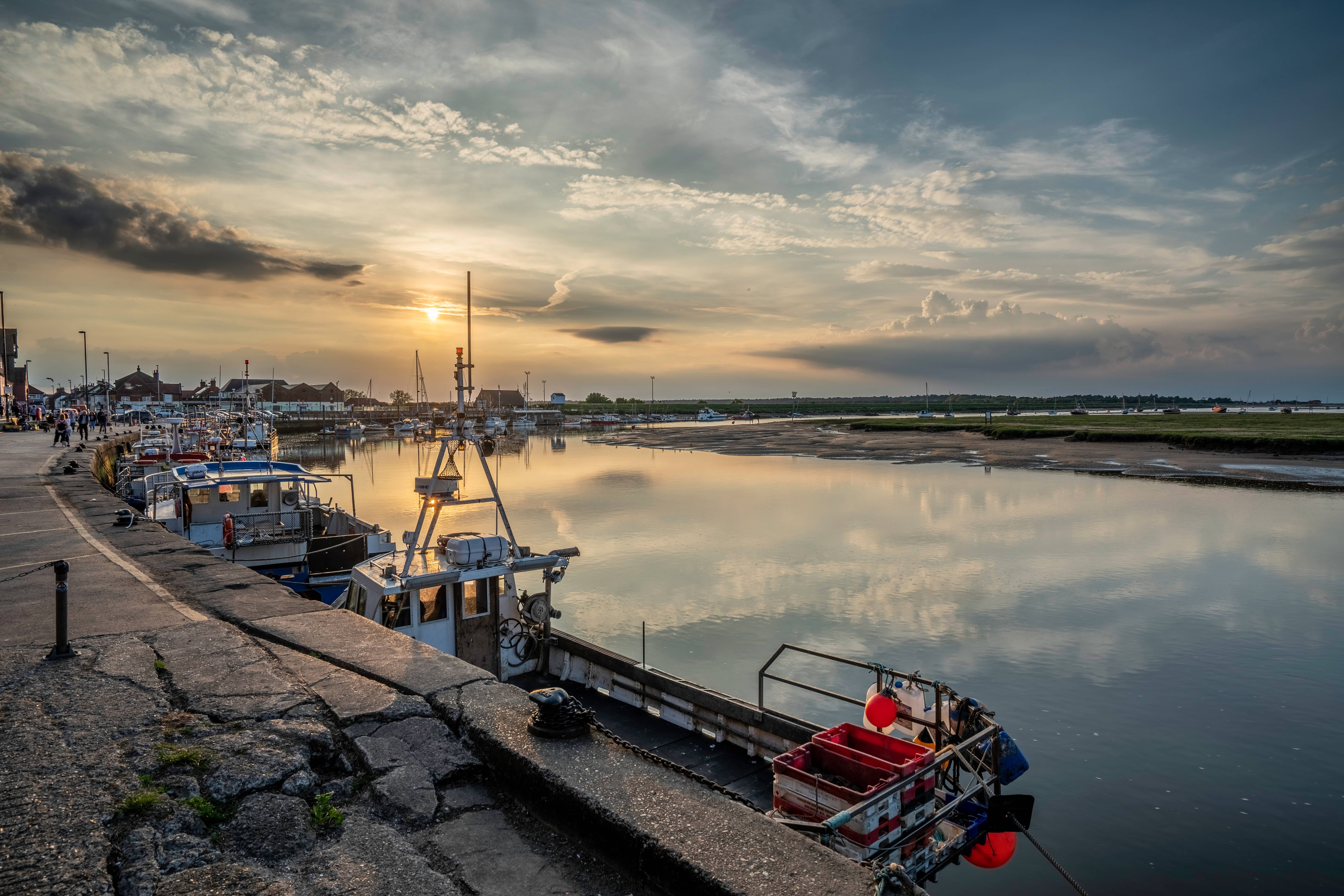
Fresh From the Sea
The small working harbour at Wells-Next-The-Sea has stunning views over shining mud creeks, shifting sand and wild saltmarsh. In winter inky black Brent geese fly low over the reeds and the masts of huddled dinghies, wrapped in their winter coats, clatter in the salty wind. Look out for the ‘Lifeboat Horse’ created by artist Rachel Long to honour the heroic horses who pulled lifeboats to the sea during the 1800s. The quiet winter season is a magical time to explore the narrow sheltered streets winding up from the blustery quayside.
If heavy weather rolls in, cosy up at Wells Maltings on Staithe Street. It features a state-of-the-art theatre, cinema, fabulous café, Heritage Centre, Visitor Information Centre, modern art gallery and spaces for community classes and events. With such a vibrant arts scene you’ll hope it rains again tomorrow! Don’t miss the giant whelk sculpture, which brings us to shellfish.
For thousands of years cold water currents have swept nutrients from Norway, resulting in a rich variety of seafood along the Norfolk coast. October to March, the cold weather season, is when the town’s mussel beds are seeded, ready to be harvested after 2.5 years. It’s hard work, but dedication and passion ensure Norfolk’s world class seafood. Wells has plenty of places to seek out these winter feasts from the sea. Try the Wells Crab House, Nelson’s Coffee House, Sands, Ollie’s, and Season. Where do they get their ingredients? All fresh from the sea!

Salt, Speed and Seafaring
Norfolk’s coastal communities grow up with their eyes on the sea and its promise of adventure. Some make history. You’ll know Admiral Lord Nelson, but how about Captain Richard Woodget?
Woodget went to sea aged 16, later becoming master of the Coldstream, a ship built in 1845, year of his birth. Impressed with Woodget’s skilful handling of the ageing ship, owner Jock Willis made him Master of the extreme clipper ship, the Cutty Sark, named after a line in Tam O’Shanter, a Robert Burns poem.
Clippers have a sharp bow, designed to cut through the waves and between 1885 and 1895 Woodget set several record-breaking times on the passage between Sydney and London. In her time as a merchant ship, Cutty Sark was crewed by men from over 30 countries and journeyed the equivalent of two and a half voyages to the moon and back.
Woodget had been baptised at St. Margaret’s Church in Burnham Norton, married at St. Clement’s Church in Burnham Overy Town and eventually retired to Flagstaff House in Burnham Overy Staithe in 1899. He died in 1928 and is buried at Burnham Norton. Home is the sailor, home from the sea.
This stunning circular walk follows in Captain Woodget’s footsteps through three of the ‘Seven Burnhams’. And of course stops at The Hero pub, named in honour of another seafaring local boy, Admiral Lord Nelson. You may have heard of him.
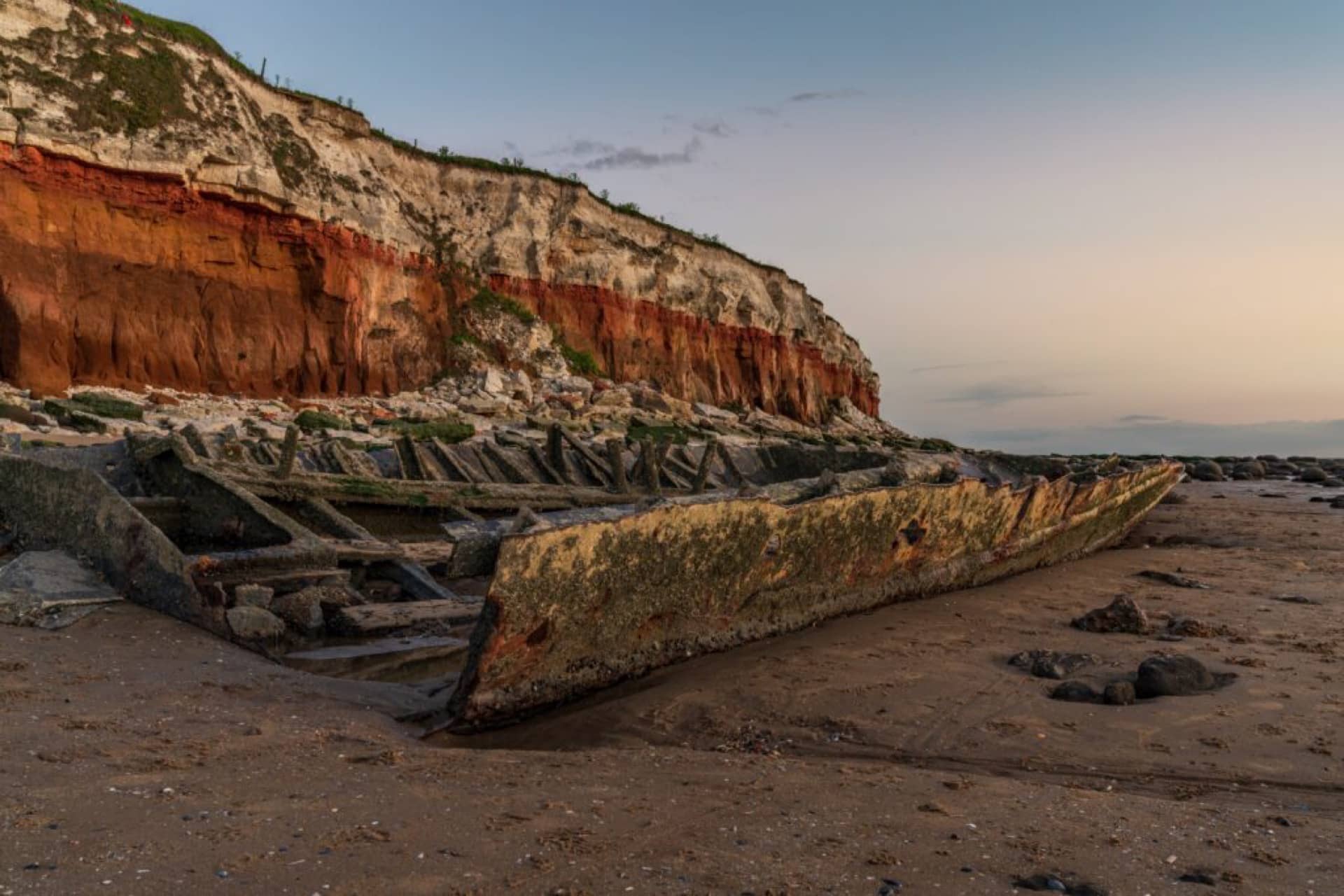
Rock & Roll
When the tide retreats, the sea reveals its secrets. At St Edmund’s Point near Old Hunstanton, the skeleton of the Sheraton lies in its last resting place on a bed of sand and rock, worn to the bone by waves and weather. Like all ships wrecked on the Norfolk coast, this once sturdy old steam trawler has its own story.
The Sheraton was built as a fishing vessel in Beverley, Yorkshire in 1907, designed to withstand the ruthless power of the North Sea when her crew set their nets off Grimsby. When the First World War broke out she was requisitioned by the Royal Navy and used for anti-submarine defences. And in the Second World War the Sheraton was busy serving her country again, now fitted with a six-pounder gun to patrol the waters of the North Sea coast. After the war she was painted daffodil yellow and used as an RAF target ship.
The Sheraton made her final voyage on the night of 23rd April 1947 when a wild gale howled in. Caught in the storm, the Sheraton broke her moorings off Lincolnshire, blew across the Wash and smashed into rocks in the shadow of Hunstanton’s striped cliffs.
Many years later, punk band The Stranglers rolled into town to pose on the beach near the remains of the Sheraton’s rusty rib cage, using Norfolk’s only rocky cliff as a backdrop for the cover of their aptly named album ‘Norfolk Coast’.
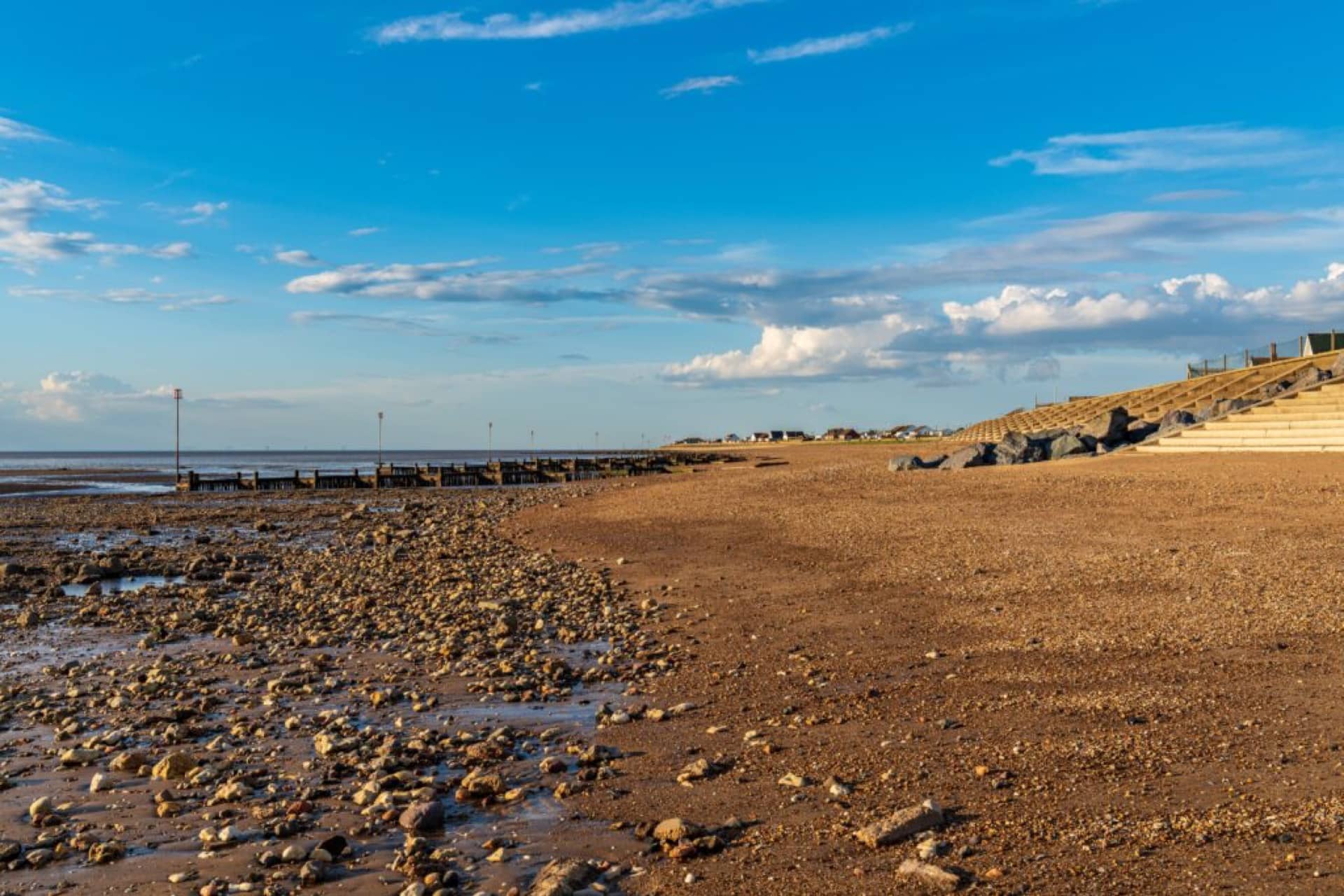
Heroes and High Water
The village of Heacham is one of the few places in eastern England where you can watch spectacular sunsets over the sea. However, on Saturday 31st January 1953, local people were troubled by a strange yellow tinge to the winter twilight. Little did they know what horror was coming. Strong winds blew up, the temperature plunged and a churning storm tide surged in, a terrifying 2 ½ metres higher than usual.
Swollen rivers burst their banks. Roads turned to rivers, fields to lakes. Train tracks and cottages were destroyed. The North Sea surge rose over 5 metres (18 ft) above average, devastating the British east coast, the Netherlands and northwest Belgium.
This catastrophic event was the worst natural disaster in British modern history. 9 people drowned in Heacham, 9 in King’s Lynn, 25 in Snettisham and 22 in Hunstanton, commemorated by a plaque at Hunstanton Heritage Gardens.
Locke Hill Farm (PE31 7QZ) was used as a local rescue base. Brothers, Stanley, Eric and Noel Linge, searched tirelessly for survivors with PC Henry Nobbs, tying ropes to telegraph poles so the flood water couldn’t sweep them away. PC Nobbs later received the British Empire Medal for bravery.
The Snettisham Circular Walk passes along the seafront, up Beach Road and past Locke Hill Farm. From the edge of the Lodge Hill woodland there are dramatic views toward the beach. Can you imagine these peaceful fields utterly consumed by the raging black sea waters of the 1953 storm?
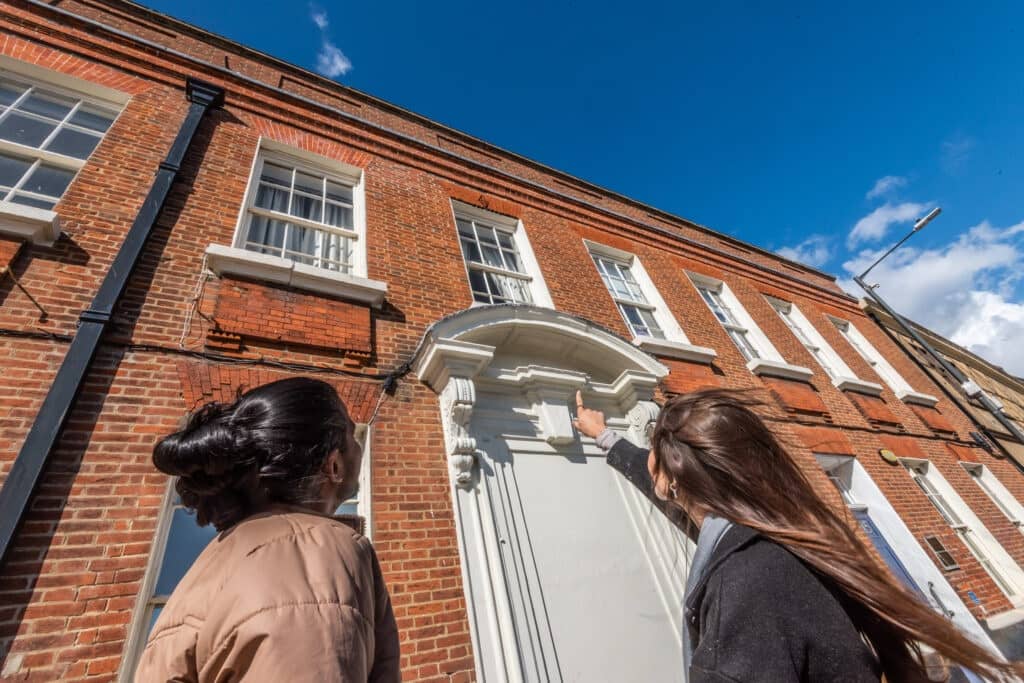
The Witches Heart
King’s Lynn. Friendly isn’t it? But this handsome West Norfolk town has a dark heart. And they say it belonged to a witch. Inside a diamond carved into the red brick above a window of Numbers 15 and 16 Tuesday Market there’s the shape of a heart, said to be the mark of Margaret Read, aka Shady Meg, who was burned at the stake in 1590. As she screamed in an agony of fire, her still-beating heart ripped itself from her chest, slammed into the wall at the marked spot and defying gravity, flew to the River Ouse where the waters bubbled like a cauldron as Meg’s heart sank beneath.
And you didn’t have to be suspected of witchcraft to meet a horrifying end. Found guilty of poisoning her mistress, in 1531 a King’s Lynn maidservant, whose lonely name is forgotten, was wrapped in chains draped over a gibbet above a cauldron of boiling water. She was plunged in, over and over again, until she died. There are only two other records of execution by boiling water in the UK, both at Smithfield in London, and both servants accused of poisoning.
But the real heartbreak is the way a society consumed by fear and superstition launches violent crusades against the most powerless. And the horror is, we still do. Can there really be justice for our murdered ancestors? How did they spend the last hours of their lives? We can at least bear witness to their infinite sorrow.
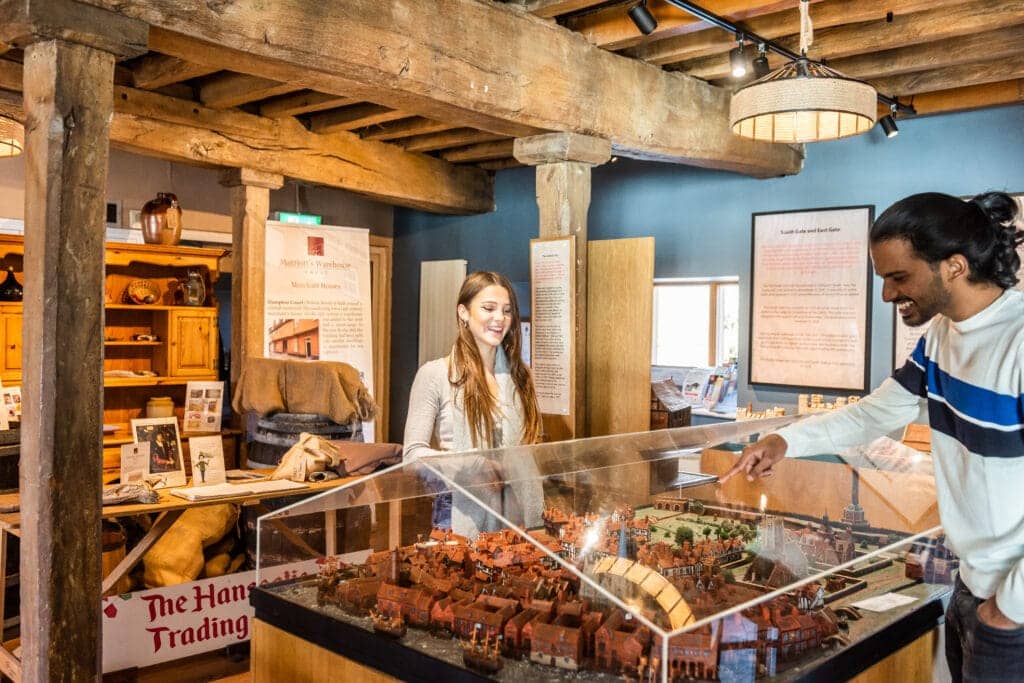
Warehouses on the Wash
On the banks of the River Ouse in King’s Lynn stands the last surviving Hanseatic building in England. The brick Hanse House gets its name from the German traders who once owned it, a relic from the days of the Hanseatic League, the powerful medieval trading bloc that stretched all the way from King’s Lynn to the heart of Russia. Lasting hundreds of years, it was one of the most successful trade alliances in history, winning the loyalty of nearly 200 towns around the North Sea and the Baltic and securing the prosperity of north west Europe.
Another reminder of King’s Lynn’s global trading prominence is Marriott’s Warehouse, now a popular restaurant with some of the finest views in town. It’s thought to have been built in its present form by local merchant Thomas Clayborne around 1580 as a store for corn, salt and wine. However, some of great oak beams date back to the 1300s, when the site was already a bustling riverside quay. It’s quiet down by the river these days, but back then the whole quayside would have been rammed with every kind of landing stage, or ‘staithe’, both public and private, where cargoes of wax, wool and pepper were unloaded by sailors and merchants, yelling orders and oaths in a cacophony of languages. Then, the tidal waters of the Ouse would have lapped around the warehouses with ships moored right outside, and by evening the town taverns were full of characters from all over Europe.

Vancouver
The maritime town of King’s Lynn was once a departure point for hundreds of young Norfolk adventurers hungry to see the world. The Lynn streets were full of sailors and merchants from overseas, spilling onto wharfs and quaysides from ships of every kind, with crews from all over the world. Vessels were unloaded and restocked from busy warehouses, corn was exported, and wines imported, a trade depicted on two figureheads of the towns Custom House.
Architect Henry Bell designed Custom House, then a centre for collecting tax on goods imported and exported from the town. In one of the upstairs rooms worked a diligent chap called John Jasper Vancouver, but it was his son, George, who gave the family name to landmarks across the globe. George Vancouver joined the Royal Navy at the mature age of 13 and accompanied Captain James Cook on two voyages including his last to Hawaii (1772-75 and 1776-80). On 1st April 1791, Vancouver took command of an expedition to chart North America’s northwestern Pacific Coast, from San Diego California to Anchorage Alaska including the Canadian province of British Columbia. His mapping measurements were so precise they can still be used today.
Vancouver Island, the city of Vancouver, Vancouver in Washington, Mount Vancouver on the Canadian American border and even New Zealand’s sixth highest mountain are all named after that man who set sail from a small town in West Norfolk when he was just a boy. His statue now stands on Purfleet Quay.

Royalty & Remembrance
Cycle through centuries of West Norfolk history on this relaxed 15 mile route round Sandringham and its pretty surroundings. First stop, Castle Rising across the Babingley River. It’s said that while on his mission to bring Christianity to East Anglia in AD 615, St Felix of Burgundy was shipwrecked on the Babingley. As luck would have it, he was rescued by some passing beavers so in thanks Felix made the chief beaver a bishop. As you do. Which is why there’s a beaver in a bishop’s mitre on the charming village sign.
Speed on to the 1150s and the building of the Church of St. Lawrence and Castle Rising’s famous Norman fortress. In the 13th century the castle was home to notorious ‘She-Wolf’, Queen Isabella, who may or may not have murdered her husband, King Edward II. We couldn’t possibly comment.
Castle Rising’s other buildings date from the 1600s, include cottages at 20 and 21 Low Road and the almshouse Trinity Hospital. Back at the Sandringham Estate you’ll pass the Norwich Gates, originally constructed for the Great Exhibition of 1862, the same year the Estate was purchased by the Prince of Wales, later King Edward VII. Sandringham House was built shortly afterward and the coastal heathland of gorse and heather transformed by the planting of Royal woods and parkland, providing local employment for generations.
Looping out past West Newton and Anmer churches, this gentle cycling route brings you back past the War Memorial through the heart of the Estate.
Build your own itinerary
If you fancy creating your own itinerary for a day trip to Norfolk or a longer visit, it couldn’t be simpler. Just go to Search Activities and select from our wide range of free and paid-for experiences, saving any that capture your imagination with the click of a button.
Once you’ve finished, you’ll find all the information stored in My Favourite, where you can drag and drop activities to create your own day-by-day itinerary! You can download this to a calendar and even share it with friends.
